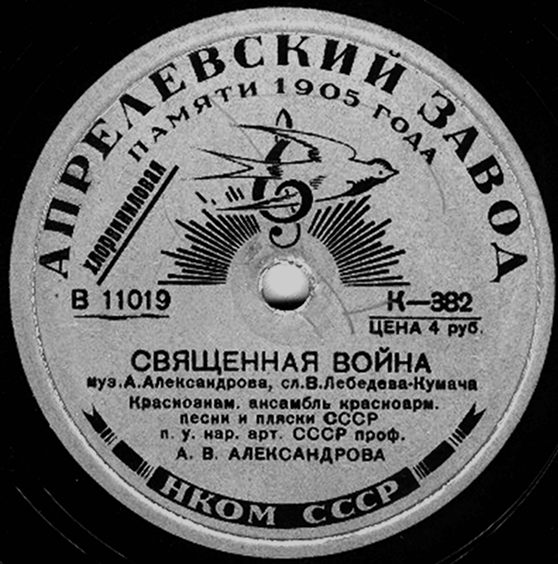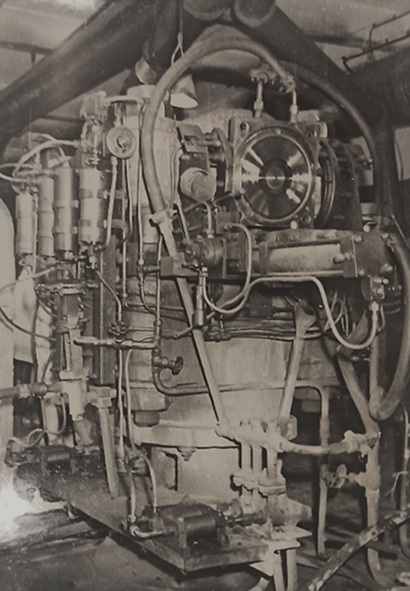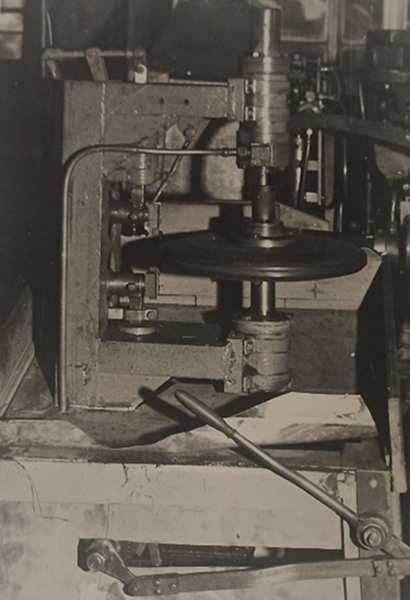In 1857 a Parisian publisher, librarian and bookseller Edouard-Léon Scott de Martinville invented a device to record sound waves and called it a “phonautograph”. The invention consisted of an acoustic cone and a vibrating membrane connected to a quill pen. The paper was smoked by an oil lamp, and the quill pen actually scratched the layer of soot. In 1860 Léon Scott captured a fragment of a French folk song on a smoked paper sheet. Since then scientists from different countries have been actively working on the methods of sound recording. This is the way Thomas Edison’s phonograph and Emile Berliner’s gramophone appeared. Gramophones and “singing black discs” gained popularity and in a short time conquered all the countries of the Old and New Worlds. Russia was no exception.
Late in the 19th century foreign manufacturers started up their representations and warehouses in Russia. In early 20th century there were over 30 gramophone companies operating in the country. Most of them were foreign and lacked their own production facilities. They earned money by selling songs popular with the Russian audience. Among the largest companies, the most famous were – the London company “Gramophone” that created a large production in Riga with a purpose to develop the market of the Russian Empire, as well as the famous French film company “Pathé Brothers”. It is known that in 1902 the Pathé house organized a tour to Russia for cameraman Legrand who filmed society chronicle here. The same year a Pathé store opened in Moscow in Gazetnaya Street where they sold phonographs, photo and movie cameras, lamps for them, etc. In 1904 a permanent back office of this company was set up in Moscow. In 1907 Pathé brothers made first attempts to produce records in our country, but they did not succeed as their records were played only on their own gramophones.
The first Russian gramophone factory appeared in 1910 in the village of Aprelevka near Moscow thanks to the industrialist of German origin. He moved from Germany to Russia in 1880. At that time the young entrepreneur was only 21 years old, he changed his name to Bogdan Vasilyevich Moll, married Agafya Alekseyevna Rubtsova, a foundry master’s daughter, and began producing cheese, soap and enamelware. In the beginning of the 20th century Bogdan Vasilyevich took an insightful decision that gramophone record production had a great future and filed a petition with the Moscow provincial government for the permission to build a “factory for the production of gramophone records with the staff of 15 to 20 people on his own land in the Moscow province of the Vereisky district near the Aprelevka estate of the Moscow-Bryansk railway”. He received the above authorization.
Bogdan Moll created a company with a full production cycle: from professional recording of musical works to the manufacture and sale of final products – gramophone records, including the production of gramophone mass, which did not exist in Central Russia. He figured out that while the newly-created company would be solving technical issues of sound recording and repertoire policy, income could be generated by the production of gramophone records for other companies. With the help of gramophone specialists invited from Germany – August Kibart and Albert Vogt – the first record with the famous gypsy song “Vagabond” was made on December 15, 1910.
The Aprelevka factory called “Metropol-Record” was based in a small one-storey building of red brick with numerous windows along the perimeter, which made the interior spacious and light. Fancy white stone trims and sophisticated built-on white turrets at the corners of the plant added elegance. During the production, wax discs with recorded sound were dipped into vats of electrolyte in the galvanic room, then copper matrices were removed from the vats and transferred to the next room where a shapeless piece of gramophone mass, compressed between the matrices of the press, turned into records. The same building also housed the machine division and the workshop where gramophone mass was made from extremely expensive shellac resin purchased abroad. The first factory director, Ivan Bogdanovich Moll (Bogdan Moll’s son), also lived there for some time. The pressing plant rapidly developed and soon had full record manufacturing cycle: recording, matrix and shellac mass production, stamping and packaging. In 1911 over 400 thousand records branded “Metropol-Record” were released there and 50 people worked at the enterprise. However, in 1913 a strike, caused by the owner’s refusal to raise prices, broke out at the factory. The strike was suppressed by the gendarmes, and its leaders – workers Sintsov, the Shmelev brothers, Firsov and Tobolkin – were arrested.
After all the difficulties of the first years with organizing the production, improving the quality of pressed records and sound recordings in the studio, searching for reliable wholesale buyers, by 1914 “Metropol-Record” captured its confident position in the Russian market. By Bogdan Moll’s initiative, the enterprise started producing sets of gramophone records for studying foreign languages for the first time in Russia. To simplify the frequent change of records, a prototype of the future micro-lift (a device to lower the gramophone needle automatically) was introduced. In 1915 the production of records increased to 500 thousand pieces a year.

After the Great October Revolution, the enterprise was nationalized and in 1919 transferred under the management of “Centropechat” to make propaganda records with speeches of Russian revolutionaries. Thus, from 1919 to 1921 thirteen Vladimir Lenin’s as well as largest communist party and government officials’ speeches were recorded on gramophone vinyls. The former director, Ivan Bogdanovich Moll, was brought in to record the speeches of the “world revolution leader”. Together with August Kibart, he actually was the technical supervisor of producing all Lenin’s gramophone records. According to witnesses, those records were in great demand among workers. Meanwhile, Bogdan Vasilyevich Moll returned to Germany, his hometown of Neumünster.
From 1922 to 1925 the factory did not operate due to the lack of raw materials. In 1927 the enterprise got the name “Gramophone Record Factory in Memory of the Year of 1905”. Production started growing when the factory was placed into the People’s Commissariat of Heavy Industry system. And already in the 1930s the plant became the main producer of gramophone records in the USSR. Back then over 1 000 workers were employed there, and the annual output reached 19 million records. In the Soviet period, when the pressing plant was actively expanding, the historical building gave no space to construct additional premises. So, the creation of the Molls, Russian industrialists of German origin, was rolled on logs to another location, and for long the factory top management was based there. By the beginning of the Great Patriotic War, new buildings were built and new equipment was installed at the plant.
In 1941 the factory and part of the team were evacuated to the Kemerovo region, to the city of Belovo. During the Great Patriotic War (1941-1945) the plant in Aprelevka produced records with the song “The Sacred War” performed by the Alexandrov ensemble. For some time, the plant helped the front and, until production was restored, it manufactured mines, shells, and shrapnel. 443 plant employees were awarded orders and medals for their participation in the Great Patriotic War and valiant work in the rear.

Restoration began in 1942. In essence, the plant was rebuilt from scratch, since the equipment was left in evacuation. Despite the difficulties of wartime and the post-war years, pre-war record production level was achieved in 1949. Thanks to further technical growth and technology improvement, the Aprelevka gramophone record plant became the leading enterprise in the country. The key accomplishment of the factory was the development of a plastic recipe based on domestic synthetic resins in 1950 by a group of plant engineers headed by Vladimir Khazanji. This advance allowed the Soviet industry not to import foreign raw materials. Thus, in the early 1950s the factory started developing the production of vinyl records, and in 1953 the team released the first long-playing gramophone records in the country.
The vinyl factory encompassed the production of gramophone records for export, gramophone plastic, matrices and press forms. Supreme quality and colorful packaging laid the foundation of well-deserved success for the vinyl factory at the International Exhibition in Brussels. The increased demand for vinyl records required further development. Resolution by the Council of Ministers No. 884 of July 30, 1958 “On increasing the production and improving the quality of gramophone vinyl records” provided for another reconstruction of the enterprise. When putting this seven-year plan into practice, a new pressing shop (the second pressing shop), a galvanic and mechanical shop were built, the energy base and warehouse facilities were expanded. The equipment was replaced with modern one and the production processes were mechanized and automated. In 1961 the first stereophonic records were released.

There were several large factories in the USSR manufacturing gramophone records: Aprelevka, Leningrad, Tashkent and Riga plants. In 1964, by a decree of the USSR Council of Ministers, they merged into All-Union firm “Melodiya” together with the All-Union recording studio, which also incorporated recording studios from Moscow, Leningrad, Tallinn, Riga, Vilnius, Tbilisi, Alma-Ata, Tashkent and some firm stores operating throughout the country. Being a monopolist in the production of gramophone vinyl records in the country and possessing the largest musical creative potential in the world, “Melodiya” carried out prodigious work on recording and releasing vinyls with classical, folk and pop music, as well as literary, historical and political records. There was no state-owned music production of scale like this anywhere else in the world. In 1964 the Aprelevka factory became part of the “Melodiya Recording Company” as the main production facility with 65 % of all records released in the Soviet Union.



The 3 000 plant team had a qualified core of workers, engineers and technical personnel. The plant constantly provided assistance in improving production to the Tashkent, Riga and Leningrad gramophone record factories.
In 1965 the Aprelevka vinyl factory produced:
- Vinyls with a regular recording — 70 million pieces;
- Vinyls with a microscopic recording (long-playing) — 30 million pieces;
- Pills for making regular vinyls — 17 thousand tons;
- Pills for making long-playing vinyls — 7 thousand tons;
- Matrices — 215 thousand pieces;
- Press forms — 700 pieces.
By the 1980s the production exceeded 50 million pieces a year.
A new era has come. At the end of the 20th century demand for vinyl records started declining sharply, the production was reduced, and new audio media — audio cassettes and CDs — entered the market. In 1989 the vinyl factory began making audio cassettes. In 1991, when the Aprelevka vinyl factory produced about 33 million records, it was already operating at a loss. In 1992 the plant was on the verge of closing down, with annual record output of approximately 10 million pieces. Working with independent customers and producing cassettes could no longer save the enterprise, and in 1997 the last edition of records was released.
Meanwhile, firm “Melodiya” mastered the technology of mass compact disc production, and in the following years its main focus was releasing old recordings from vinyls on compact discs. Little-known or even “laid on a shelf” in the Soviet years, records released by “Melodiya” could be considered re-discovered.
Nowadays, the legendary brand “Firmа Melodiya” is a modern enterprise with a confident position in the Russian and world recording market and wide cooperation with foreign partners.
In 2024, the year of “Melodiya” 60th anniversary, the company’s top management decided to launch a full-cycle vinyl record production plant in Novosibirsk.
“We’re all witnessing keen demand and trend for vinyl records, and indeed, even those people who do not have any special equipment at home, buy vinyl records as a souvenir, a serious sign of affection for their favorite artists, besides, many companies are increasingly using them as corporate gifts. The market is developing and varying, yet at the same time, it is “Firma Melodiya” that most of our compatriots still associate with vinyl records with a huge diversity of genres for Soviet and Russian listeners – from classical music to fairy tales for kids, from popular Soviet music to ethnic works of various nationalities, which “Melodiya” retains and protects with the same care and respect as modern Russian music. Therefore, “Melodiya” decided to renew the production of vinyl records under its own name – after all, who except “Melodiya” – being the founder of the vinyl trend in the USSR – can continue it today? The revival of vinyl production with “Melodiya” brand is quite logical, it’s the natural renewal of musical traditions in our country, which, in the context of growing vinyl market, will allow the factory to become a worthy successor to the traditions of the Soviet “Melodiya” plants”, notes Andrey Krichevsky, “Melodiya” General Director.

The new enterprise is called “Novosibirsk sound recording production plant – “Firma Melodiya”. Its crucial task is to expand the vinyl market in Russia so that more music is available to listeners and purchased on vinyl, and the factory, planning to produce the widest range of products and cooperate with artists, authors, labels and other customers, is capable of fulfilling this goal. For this purpose, the Chinese-Italian high-tech line with new equipment is installed at the new plant. The priority is the quality of the manufactured products.
The vinyl factory is not limited to “Melodiya” catalogue and produces records by a wide variety of artists. Any customer – artist, author, label, agency, copyright holder – can make an order and release an album or a single.
The re-emergence of vinyl production by “Melodiya” is not just a tribute to the memory of a cultural “giant”, it’s something that really resonates in people’s hearts.


